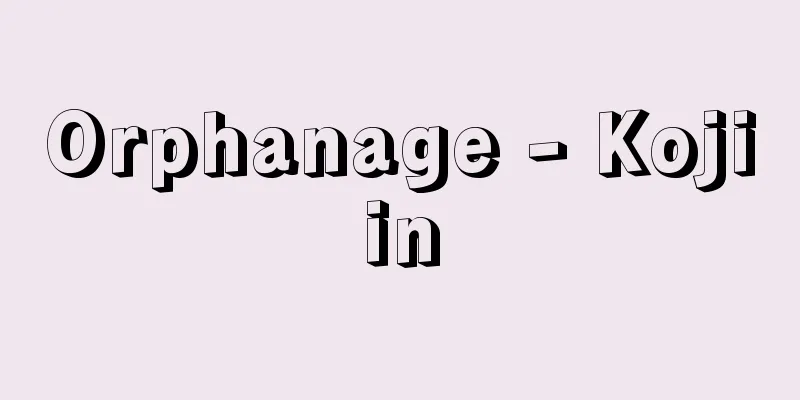Orphanage - Kojiin

|
A social welfare facility that houses and cares for orphaned children who have lost their parents due to death or abandonment. It was also called a relief center. The term "orphanage" first became an official term in the Relief Act promulgated in 1929 (Showa 4). However, this term was too explicit and led to discrimination. Therefore, the name was changed to "foster care facility" in the Child Welfare Act promulgated in 1947 (Showa 22). Furthermore, with the 50th amendment of the Child Welfare Act in 1997 (Heisei 9), the term "foster care facility" was renamed to "child welfare facility." In Japan, child relief facilities began to be established from the 1870s onwards, directly triggered by the first economic depression under Japanese capitalism in 1890 (Meiji 23) and the mass production of orphaned and abandoned children following the Nobi earthquake in 1891, and more fundamentally as a response to the formation of a lower class society that accompanied the establishment of Japanese capitalism. Many of these child relief facilities were run by private organisations, mainly religious organisations, with a Christian background in particular. The Okayama Orphanage, founded in 1887 by Ishii Juji, was the first to use the word orphanage in its name, and was the largest of its kind during the Meiji period. Internationally, the Barnard Home, founded in 1870 by Thomas John Barnardo (1845-1905) of England, who also influenced Ishii, is well known. Instead of the large facilities that had been in place up until then, Barnard Home adopted a small-house system in which a married couple of caregivers and a small number of children lived the daily lives of an ordinary family in a building similar in size to an ordinary home, and provided vocational education and aftercare, contributing to the modernization of child care facilities. [Kazuhiko Yokoyama] "Yoshio Sarai, 'Ishii Juji and the Okayama Orphanage', 2nd Edition (1995, Committee for Reconstruction of the Bronze Statue of Mr. Ishii Juji)" [Reference] | | | | |Source: Shogakukan Encyclopedia Nipponica About Encyclopedia Nipponica Information | Legend |
|
死別、遺棄などによって両親を失った身寄りのない子供を収容し保育する社会事業施設。救育所ともいった。孤児院という名称は、1929年(昭和4)公布の救護法で初めて公用語となった。しかし、このことばは、その内容をあまりにも露骨に表し、差別感をも招いた。そのため、47年(昭和22)公布の児童福祉法で養護施設という名称に変わった。また、97年(平成9)の児童福祉法第五〇次改正により、養護施設は児童養護施設と改称された。 日本における児童救済施設は明治10年代以降つくられ始め、1890年(明治23)の日本資本主義最初の経済恐慌、91年の濃尾(のうび)地震による孤児・棄児の大量発生を直接的契機に、より基本的には日本資本主義の成立に伴う下層社会の形成に対応するものであった。児童救済施設は、民間団体のおもに宗教団体、とくにキリスト教的背景をもつものが多い。なかでも石井十次(じゅうじ)によって1887年に設立された岡山孤児院は、施設名に孤児院ということばを最初に使った、明治年間最大の孤児院であった。 国際的には、石井にも影響を与えたイギリスのバーナードThomas John Barnardo(1845―1905)によって1870年に設立されたバーナード・ホームが有名である。バーナード・ホームは、従来の大収容施設にかわり、一般家庭の住居規模に近い建物で、夫婦者の保父・保母を中心に少人数の子供が一般家庭のような日常生活を送る小舎制を採用し、職業教育、アフター・ケアなどを行い、児童収容施設の近代化に貢献した。 [横山和彦] 『更井良夫著『石井十次と岡山孤児院』第2版(1995・石井十次先生銅像再建委員会)』 [参照項目] | | | | |出典 小学館 日本大百科全書(ニッポニカ)日本大百科全書(ニッポニカ)について 情報 | 凡例 |
Recommend
Porter - Bocca
To carry loads on one's back and cross a mount...
Zhou Chen (English name)
A Chinese painter from the mid-Ming Dynasty. Born ...
Incitement - Sendozai
This is a crime that involves appealing strongly t...
Nitrosation - Nitroso (English spelling) nitrosation
A reaction to introduce the nitroso group -NO into...
Saw - Kobiki
The people who were anciently called soma (somabit...
Light of the House - Ienohikari
This magazine was launched in April 1925 (Taisho ...
Anafil - Anafil
...The technique is often depicted in Persian, Tu...
Eads Bridge - Eads Bridge
Eads Bridge : A bridge over the Mississippi River ...
virtutes cardinales (English spelling) virtutes cardinales
… The characteristics of Christian morality are m...
Izumo mythology - Izumo mythology
A mythology centered on Izumo. After being driven ...
Bourdon, E.
The aneroid barometer was named after the Greek w...
Abnormal weather - Ijōkishou (English spelling) unusual weather
A rare weather condition that occurs approximatel...
Silla pottery - Shiragi-doki
This type of pottery is a gray-blue, dark black ha...
Thick wood - Atsukyogi
…It first appeared around the 15th century, and f...
Digital transmission
A method of communication that transmits informati...









